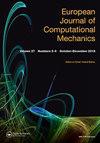Dynamic Finite Element Analysis of Flexible Double Wishbone Suspension Systems with Different Damping Mechanisms
IF 0.6
Q3 MECHANICS
引用次数: 1
Abstract
Suspension systems in running vehicles keep the occupants comfortable and isolated from road noise, disturbances, and vibrations and consequently prevent the vehicle from damage and wearing. To attain comfortable and vibration isolation conditions, both material flexibility and damping should be considered in the considered suspension model. This paper presents an incremental finite element model to study and analyze the dynamic behavior of double wishbone suspension systems considering both material flexibility and damping effects. The flexibility of the suspension links are modeled with plane frame element based on Timoshenko beam hypothesis (TBH). On the other hand, the flexibility of joints connecting the suspension links together and with the vehicle chassis is modeled with the revolute joint element. To incorporate the damping effect, viscoelastic, viscous and proportional damping are considered. An incremental viscoelastic constitutive relations, suitable for finite element implementation, are developed. The developed finite element equations of motion are solved using the Newmark technique. The developed procedure is verified by comparing the obtained results with that obtained by the developed analytical solution and an excellent agreement is found. The applicability and effectiveness of the developed procedure are demonstrated by conducting parametric studies to show the effects of the road irregularities profiles, the vehicle speed, and the material damping on the transverse deflection and the resultant stresses of suspension system. Results obtained are supportive in the mechanical design, manufacturing processes of such type of structural systems.不同阻尼机构柔性双叉骨悬架系统动力学有限元分析
行驶中的车辆的悬架系统使乘客保持舒适,并与道路噪音、干扰和振动隔离,从而防止车辆损坏和磨损。为了获得舒适的隔振条件,在所考虑的悬架模型中应考虑材料的柔性和阻尼。本文提出了一个增量有限元模型来研究和分析考虑材料柔性和阻尼效应的双叉臂悬架系统的动力学行为。基于Timoshenko梁假设(TBH),采用平面框架单元对悬架连杆的柔性进行了建模。另一方面,将悬架连杆连接在一起以及与车辆底盘连接的关节的柔性用旋转关节单元建模。为了考虑阻尼效应,考虑了粘弹性、粘性和比例阻尼。建立了适用于有限元计算的增量粘弹性本构关系。利用Newmark技术对所建立的有限元运动方程进行求解。通过将所获得的结果与所开发的分析解进行比较,验证了所开发的程序,并发现了极好的一致性。通过进行参数研究来证明所开发程序的适用性和有效性,以显示道路不规则性轮廓、车辆速度和材料阻尼对悬架系统横向偏转和合成应力的影响。所获得的结果对此类结构系统的机械设计、制造过程具有支持作用。
本文章由计算机程序翻译,如有差异,请以英文原文为准。
求助全文
约1分钟内获得全文
求助全文

 求助内容:
求助内容: 应助结果提醒方式:
应助结果提醒方式:


